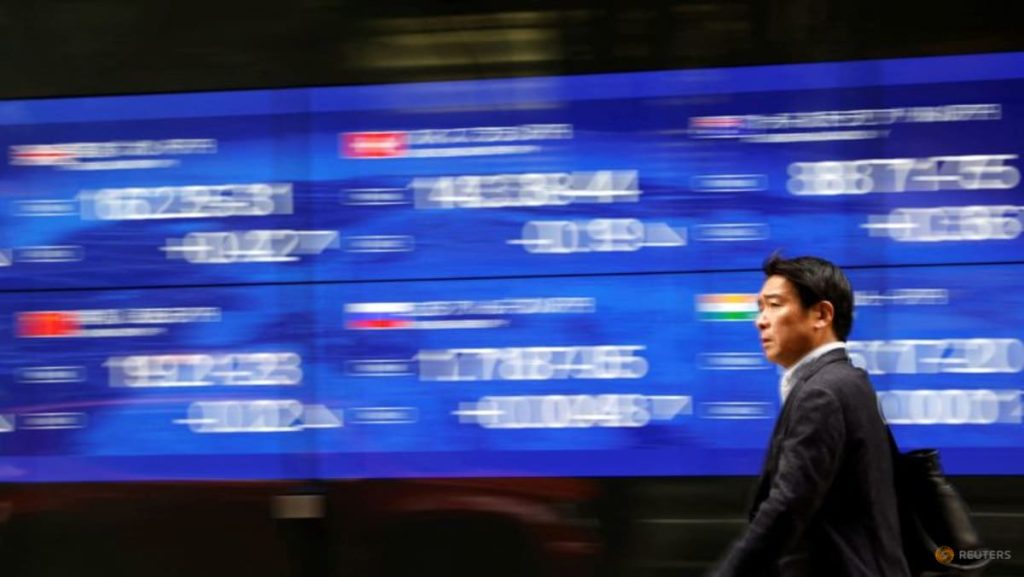LONDON/SYDNEY :World stocks held strong on Monday as traders bet on U.S. rate cuts and Japanese stimulus spending, balancing jitters about U.S. regional banks with hopes for a quarterly earnings boom for Wall Street’s dominant artificial intelligence titans.
Trading in Wall Street stock futures implied the blue chip S&P 500 share index and tech-heavy Nasdaq 100 would open about 0.3 per cent higher as anticipated market volatility stayed relatively high.
The VIX measure of expected choppiness on the S&P 500 hit its highest level last week since U.S. President Donald Trump unleashed threats of punitive trade tariffs on April 2. On Monday it stuck at 21, still above its long-run average.
“Risks are just piling up everywhere,” Fidelity International multi-asset manager Caroline Shaw said. “There’s… a lot of volatility behind that.”
A rotation into international stocks was also evident on Monday, with European equities 0.6 per cent higher and Japan’s Nikkei jumping 2.8 per cent to a record as a coalition deal set the stage for pro-stimulus Sanae Takaichi to become prime minister.
AI DRIVES WALL STREET AS CREDIT DOUBTS RISE
Safe-haven gold rose 0.3 per cent on Monday to $4,263 an ounce after jumping 6 per cent last week in response to broadening doubts about the U.S. credit sector and stress signals flaring across the nation’s regional banks.
JPMorgan CEO Jamie Dimon warned last week that more “cockroaches” would turn up in credit markets after two automotive sector bankruptcies in September.
Such trends were making it even more crucial that AI titans like Nvidia and Microsoft do not signal any slowdown in their own capital expenditure or business investment plans for the new tech in upcoming earnings, investors said.
“If the U.S. market starts coming down because the AI theme runs out of steam, everything’s coming down. You just don’t want to be in equities at that point,” Janus Henderson multi-asset manager Oliver Blackbourn said
U.S. households’ stock market exposure has reached a 75-year high as a proportion of overall wealth, with optimism about tech earnings driving retail investor participation while performance between AI and the rest of the market diverges.
The proportion of S&P 500 stocks that are on a downtrend has almost doubled to 44 per cent since July.
As investors stay nervous about U.S. regional banks’ earnings that are about to roll in, some said tighter credit conditions could remove some froth from AI share prices even if data centre and advanced chip spending kept booming.
“I wouldn’t say it’s early innings for big tech but I think there’s still enough scope for healthy returns,” said Jason da Silva, Arbuthnot Latham global investment strategy director, who remained positive on U.S. equities.
According to LSEG IBES data, analysts have forecast 8.8 per cent year-on-year growth for S&P 500 companies overall for this quarter.
Earnings reports in upcoming days that could also influence sentiment include those from Tesla and Netflix, while consumer groups Procter & Gamble and Coca-Cola might provide a snapshot of how the U.S. economy is doing.
RATE CUT BETS IN JOBS DATA VACUUM
Traders are placing unanimous bets that the Federal Reserve will cut rates by a quarter-point next month and again in December, with its funds rate dropping to 3 per cent next year as central bank chair Jay Powell has not pushed back against this optimism.
But the Fed will also go into its next policy meeting without full visibility on how the U.S. economy is faring because a White House shutdown since October 1 has suspended the release of employment data that it watches closely.
Core inflation data due on Friday are also expected to show that price growth held at 3.1 per cent in September, sticking stubbornly above the Fed’s average 2 per cent target.
The 10-year Treasury yield, which sets the tone for global corporate and household debt costs, has fallen more than 50 basis points since June and was last at about 4.01 per cent.
The Fed cut theme has also helped to further depress the U.S. dollar against European and higher-yielding currencies, with the euro edging up to $1.1662 on Monday after withstanding pressure from last week’s surprise credit downgrade of France by ratings agency Standard & Poor’s.
The greenback at least held its own against the Japanese yen on Monday, as currency markets reduced the odds of a Bank of Japan rate hike this month to just over 20 per cent and viewed the central bank as likely to support government stimulus efforts over battling inflation.
In commodities, oil was pressured by OPEC+ supply plans and international benchmark Brent crude eased 0.8 per cent to $60.8 a barrel.


